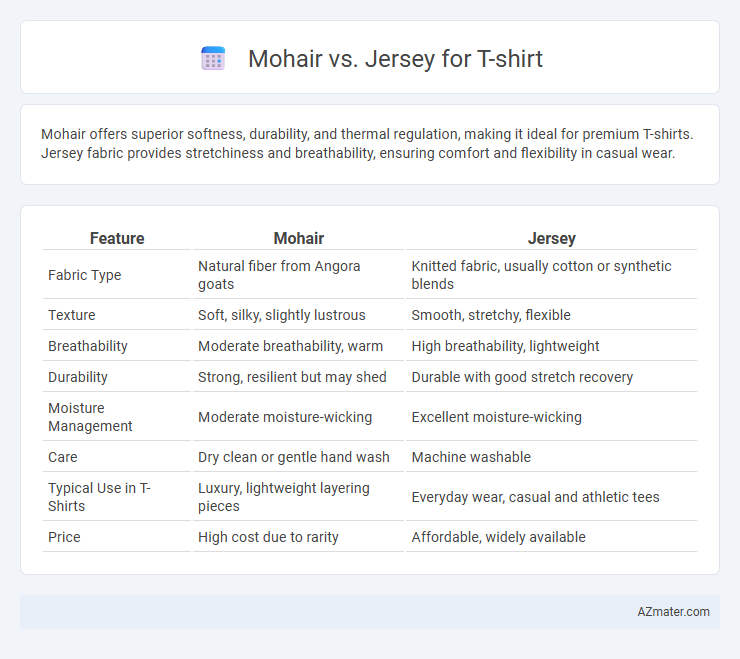Mohair offers superior softness, durability, and thermal regulation, making it ideal for premium T-shirts. Jersey fabric provides stretchiness and breathability, ensuring comfort and flexibility in casual wear.
Table of Comparison
| Feature | Mohair | Jersey |
|---|---|---|
| Fabric Type | Natural fiber from Angora goats | Knitted fabric, usually cotton or synthetic blends |
| Texture | Soft, silky, slightly lustrous | Smooth, stretchy, flexible |
| Breathability | Moderate breathability, warm | High breathability, lightweight |
| Durability | Strong, resilient but may shed | Durable with good stretch recovery |
| Moisture Management | Moderate moisture-wicking | Excellent moisture-wicking |
| Care | Dry clean or gentle hand wash | Machine washable |
| Typical Use in T-Shirts | Luxury, lightweight layering pieces | Everyday wear, casual and athletic tees |
| Price | High cost due to rarity | Affordable, widely available |
Introduction to Mohair and Jersey Fabrics
Mohair fabric, derived from the Angora goat's long, silky hair, is renowned for its luxurious softness, exceptional sheen, and natural insulating properties, making it an exquisite choice for premium T-shirts. Jersey fabric, primarily made from cotton or a cotton blend, is characterized by its lightweight, stretchy knit, and breathable texture, ideal for everyday T-shirts focused on comfort and versatility. Understanding the distinct fiber content and texture differences between mohair and jersey highlights their unique benefits in T-shirt design and functionality.
Origin and Production of Mohair
Mohair, sourced from the Angora goat native to Turkey, is renowned for its silky texture and durability, making it a premium fabric choice compared to conventional cotton jersey. The production of mohair involves shearing the goats twice a year, followed by a meticulous cleaning and spinning process that preserves its natural sheen and insulating properties. Jersey, typically made from cotton or synthetic blends, contrasts with mohair by offering a lightweight, stretchable fabric but lacks the unique origin and luxurious feel inherent to mohair fibers.
Jersey Fabric: Composition and Characteristics
Jersey fabric is predominantly made from cotton, polyester, or a blend of both, offering a soft, breathable, and stretchy material ideal for T-shirts. Its knit structure provides excellent flexibility and comfort, making it a popular choice for casual wear and activewear. The smooth surface and durability of jersey fabric ensure it maintains shape and color after multiple washes, enhancing its long-term appeal.
Texture and Feel: Mohair vs Jersey
Mohair fabric features a silky, lustrous texture derived from the Angora goat's hair, offering a soft yet slightly coarse feel that provides warmth and breathability. Jersey fabric, typically made from cotton or a cotton blend, has a smooth, stretchy texture with a light, comfortable softness ideal for everyday wear. The key difference lies in Mohair's luxurious sheen and warmth compared to Jersey's breathable, flexible, and smooth surface suitable for casual t-shirts.
Breathability and Comfort Comparison
Mohair fabric offers superior breathability compared to jersey, thanks to its natural fibers that wick moisture effectively and promote air circulation, keeping the wearer cool and dry. Jersey, typically made from cotton or synthetic blends, provides a soft, stretchy feel but may trap heat, making it less breathable in hot conditions. Comfort-wise, mohair is luxurious and lightweight, ideal for sensitive skin, while jersey is favored for its smooth texture and flexibility, suitable for casual, everyday wear.
Durability and Longevity
Mohair offers exceptional durability due to its strong, resilient fibers that resist wear and tear, making it ideal for long-lasting t-shirts. Jersey, typically made from cotton or synthetic blends, provides moderate durability but may show signs of pilling and stretching over time. For longevity, mohair t-shirts maintain their shape and texture longer, whereas jersey fabric requires more frequent replacement due to fiber breakdown.
Moisture-Wicking and Care Requirements
Mohair offers excellent moisture-wicking properties due to its natural fiber structure, efficiently drawing sweat away from the skin and keeping the wearer dry during intense activities. Jersey fabric, typically made from cotton or synthetic blends, provides moderate moisture management but tends to retain more moisture compared to mohair, making it less ideal for high-performance wear. Care requirements for mohair involve gentle hand washing or dry cleaning to maintain fiber integrity, while jersey is generally machine washable and more durable for everyday use.
Suitability for Different Climates
Mohair offers excellent insulation and breathability, making it ideal for cooler climates or transitional seasons, as it effectively regulates body temperature and resists moisture. Jersey fabric, typically lightweight and stretchy, is better suited for warm to moderate climates due to its softness, breathability, and moisture-wicking properties that keep the wearer cool and comfortable. Both fabrics provide distinct climate advantages, with mohair favoring insulation and jersey prioritizing ventilation.
Style and Versatility in T-Shirt Design
Mohair offers a luxurious sheen and soft texture that elevates T-shirt style, lending a sophisticated, high-end look ideal for statement pieces. Jersey fabric provides exceptional versatility with its smooth, stretchy knit that adapts to casual and sporty designs, ensuring comfort and a flattering fit. Combining mohair's elegant finish with jersey's flexibility results in T-shirts that balance refined aesthetics with everyday practicality.
Mohair vs Jersey: Which Is Right for Your T-Shirt?
Mohair offers a luxurious, silky feel with excellent moisture-wicking and durability, making it ideal for premium T-shirts that prioritize comfort and longevity. Jersey fabric, typically made from cotton or synthetic blends, provides a soft, stretchy, and breathable option that suits everyday casual wear and active lifestyles. Choosing Mohair vs Jersey depends on whether you seek high-end texture and resilience or affordable flexibility and ease of care for your T-shirt.

Infographic: Mohair vs Jersey for T-Shirt
 azmater.com
azmater.com